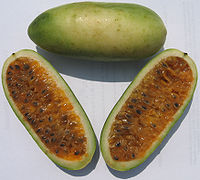
Banana passionfruit
Encyclopedia

Banana
Banana is the common name for herbaceous plants of the genus Musa and for the fruit they produce. Bananas come in a variety of sizes and colors when ripe, including yellow, purple, and red....
with rounded ends. It was given this name in New Zealand, where passionfruit are also prevalent. In Hawaii, it is called banana poka. In its Latin American homeland, it is known as curuba, curuba de Castilla, or curuba sabanera blanca (Colombia); taxo, tacso, tagso, tauso (Ecuador); parcha (Venezuela), tumbo or curuba (Bolivia); tacso, tumbo, tumbo del norte, trompos, or tintin (Peru).
There are several species of banana passion fruit, for example:
- P. tripartita var. mollissima
- P. tarminianaPassiflora tarminianaPassiflora tarminiana is a species of passionfruit. The yellow fruits are edible and their resemblance to small, straight bananas has given it the name banana passionfruit in some countries. It is native to the uplands of tropical South America and is now cultivated in many countries. In Hawai'i...
Mollissima and its close relative Passiflora mixta are vines with cylindrical stems densely coated with yellow hairs, and are vigorous climbers, growing up to seven metres. The leaves are a shiny green with clearly defined veins, the flower is large, pink and green petalled with a yellow and white centre. The fruit is yellow-orange when ripe and contains a sweet edible orange-colored pulp with black seeds.
The banana passionfruit is native to the Andean valleys from Venezuela
Venezuela
Venezuela , officially called the Bolivarian Republic of Venezuela , is a tropical country on the northern coast of South America. It borders Colombia to the west, Guyana to the east, and Brazil to the south...
to Peru
Peru
Peru , officially the Republic of Peru , is a country in western South America. It is bordered on the north by Ecuador and Colombia, on the east by Brazil, on the southeast by Bolivia, on the south by Chile, and on the west by the Pacific Ocean....
. It was domesticated around the time of the Spanish Conquest and today it is commonly cultivated and its fruit are regularly sold in local markets. The vine is grown in California as an ornamental under the name "softleaf passionflower". It is grown to some extent in Hawaii
Hawaii
Hawaii is the newest of the 50 U.S. states , and is the only U.S. state made up entirely of islands. It is the northernmost island group in Polynesia, occupying most of an archipelago in the central Pacific Ocean, southwest of the continental United States, southeast of Japan, and northeast of...
and the State of Madras, India
India
India , officially the Republic of India , is a country in South Asia. It is the seventh-largest country by geographical area, the second-most populous country with over 1.2 billion people, and the most populous democracy in the world...
.
P. tripartita var. mollissima and P. tarminiana were until recently considered to be one species, P. mollissima.
Invasive species
P. tarminiana and P. tripartita thrive in the climate of New ZealandNew Zealand
New Zealand is an island country in the south-western Pacific Ocean comprising two main landmasses and numerous smaller islands. The country is situated some east of Australia across the Tasman Sea, and roughly south of the Pacific island nations of New Caledonia, Fiji, and Tonga...
. They are invasive species
Invasive species
"Invasive species", or invasive exotics, is a nomenclature term and categorization phrase used for flora and fauna, and for specific restoration-preservation processes in native habitats, with several definitions....
since they can smother forest margins and forest regrowth. It is illegal to sell, cultivate and distribute the plants.
Banana passionfruit vines are now smothering more than 200 square miles (518 km²) of native forest on the islands of Hawaii and Kauai. Seeds are spread by feral pigs, birds and humans. The vine can also be found all across the highlands of New Guinea
New Guinea
New Guinea is the world's second largest island, after Greenland, covering a land area of 786,000 km2. Located in the southwest Pacific Ocean, it lies geographically to the east of the Malay Archipelago, with which it is sometimes included as part of a greater Indo-Australian Archipelago...
.
Banana passionfruit is used as rootstock for grafting the passionfruit varieties more commonly grown for food, especially in climates too cool for productive passionfruit growing. Regrowth from beneath the graft is one means of its outbreak as a weed, so growers should be vigilant for sprouting low on the main stem or from around the base of the plant, and should pull up and discard the plant when (typically after 6-9 years) the grafted passionfruit is no longer productive.
External links
- Purdue University (United States) - Banana passionfruit

